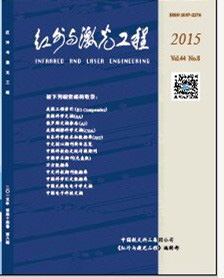Hua Haoran, Yuan Lihua, Wu Guanhua, Wu Wei. Defect quantitative detection based on transmission infrared thermal wave method[J]. Infrared and Laser Engineering, 2016, 45(2): 204007-0204007(6). doi: 10.3788/IRLA201645.0204007
| Citation:
|
Hua Haoran, Yuan Lihua, Wu Guanhua, Wu Wei. Defect quantitative detection based on transmission infrared thermal wave method[J]. Infrared and Laser Engineering, 2016, 45(2): 204007-0204007(6). doi: 10.3788/IRLA201645.0204007
|
Defect quantitative detection based on transmission infrared thermal wave method
- 1.
Key Laboratory of Nondestructive Testing(Ministry of Education),Nanchang Hangkong University,Nanchang 330063,China
- Received Date: 2015-06-21
- Rev Recd Date:
2015-07-19
- Publish Date:
2016-02-25
-
Abstract
Pulsed infrared thermal wave testing, which typically uses reflective-type incentives, is a new non-destructive testing technology. In view of the reflection method with big defect depth quantitative detection error, transmission infrared thermal wave method was systematically analyzed in order to improve the detection precision. The principle of infrared measurement of defect depth was discussed by analyzing the material in pulsed thermal excitations of one-dimensional heat transfer model. The relationship between the characteristics of time and defect depth was established by the peak time method of the first order differential of surface temperature, so the quantitative detection on the depth of defect was realized. The sample of PVC flat with artificial slot wedge defects was used. The depth of defects were detected by comparative experiments between transmission and reflection methods, and the measurement errors were analyzed. The results show that reflection method in quantitative calculation for defects requires selecting reference region, while transmission method does not rely on the reference avoiding the error resulted from it. Moreover, transmission method directly heats surface defects, so short response time can be obtained and the defect depth precision are improved greatly by solving the characteristic time of the defect.
-
References
|
[1]
|
Sun Chunqing, Shi Yu. Numerical simulation of infrared fast defects detection[J]. Journal of Mechanical Electrical Engineering, 2011(3):314-315.(in Chinese) |
|
[2]
|
|
|
[3]
|
Ghosh K K, Karbhari V M. Use of infrared thermography for quantitative non-destructive evaluation in FRP strengthened bridge systems[J]. Material and Structures, 2011, 44(1):169-185. |
|
[4]
|
|
|
[5]
|
|
|
[6]
|
Lahiri B B, Bagavathiappan S, Reshmi P R, et al. Quantification of defects in composites and rubber materials using activethermography[J]. Infrared Physics Technology, 2012:191-199. |
|
[7]
|
Li Guohua, Lin Xiaofeng, Gao Juchun. Numerical simulation of infrared thermographical NDT ofpipeline with internal corrosion[J]. Mining Processing Equipment, 2012(9):118-122.(in Chinese) |
|
[8]
|
|
|
[9]
|
|
|
[10]
|
Zeng Zhi, Tao Ning, Feng Lichun, et al. Effect of defect size on the measurement of defect depth usingthermal wave imaging[J]. Infrared and Laser Engineering, 2012, 41(7):1910-1915.(in Chinese) |
|
[11]
|
Sun Qingchun. Quantification research for steel and aluminum plate with Infrared detection[D]. Xiangtan:Hunan University of Science and Technology, 2011.(in Chinese) |
|
[12]
|
|
|
[13]
|
|
|
[14]
|
Hsieh C K, Su K U. A methodology of predicting cavity geometry based on scanned surface temperature data-prescribed surface temperature at cavity side[J]. ASME Journal of Heat Transfer, 1980, 102:324-329. |
|
[15]
|
|
|
[16]
|
Sahnoun S, Belattar S. Thermal non-destructive testing study of a circular defect in plane structure[J]. British Journal of NDT, 2003(8):115-121. |
|
[17]
|
|
|
[18]
|
Sakagami Tkubo S. Applications of pulse heating thermography and lock-in thermography to quantitative non-destructive evaluations[J]. Infrared Physics and Technology, 2002, 43:271-278. |
|
[19]
|
|
|
[20]
|
Huo Yan, Zhang Cunlin. Quantitative infrared prediction method for defect depth in carbon fiber reinforced plastics composite[J]. Acta Phys Sinica, 2012, 61(14):144204.(in Chinese) |
|
[21]
|
|
|
[22]
|
Li Meihua, Zeng Zhi, Shen Jingling, et al. Numerical simulation of defects depth quantitative measurementin pulsed infrared nondestructive testing[J]. Infrared and Laser Engineering, 2013, 42(4):875-879.(in Chinese) |
|
[23]
|
Hou Zhenbing, He Shaojie, Li Shuxian. Heat Conduction in Solid[M]. Shanghai:Shanghai Scientific and Technical Publishers, 1984.(in Chinese) |
|
[24]
|
|
|
[25]
|
Zhang Xiaochuan. Determination of infrared thermal wave nondestructive testing technology in defect size[D]. Beijing:Capital Normal University, 2006.(in Chinese) |
-
-
Proportional views

-









 DownLoad:
DownLoad: